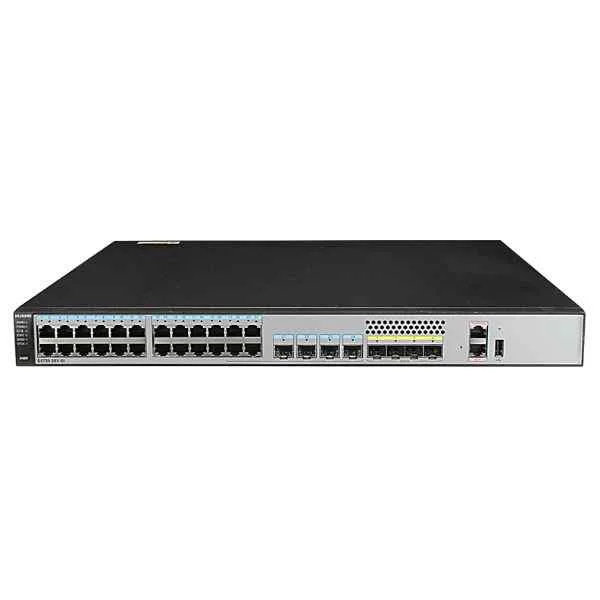Overview Of S5320-36C-EI-28S-DC
No Data FoundSpecification Of S5320-36C-EI-28S-DC
S5320-36C-EI-28S-DC Datasheet
S5320-36C-EI-28S-DC Specification
S5320-36C-EI-28S-DC Specification |
|
|
Fixed Ports |
28100/1000Base-X(4GE Combo), 410 Gig SFP+ |
|
Extended slot
|
One extended slot that supports an uplink interface card or private stack card |
|
MAC Address Table |
IEEE 802.1d 64K MAC address entries MAC address learning and aging Static, dynamic, and blackhole MAC address entries Packet filtering based on source MAC addresses |
|
VLAN Features |
4K VLANs Guest VLAN and voice VLAN GVRP MUX VLAN VLAN assignment based on MAC addresses, protocols, IP subnets, policies, and ports 1:1 and N:1 VLAN mapping VLAN-based transparent transmission of protocol packets |
|
Jumbo frame |
12K |
|
Ring protection
|
RRPP ring topology and RRPP multi-instance Smart Link tree topology and Smart Link multi-instance, providing millisecond-level protection switchover Smart Ethernet Protection (SEP),G.8032 Ethernet Ring Protection Switching (ERPS) STP (IEEE 802.1d), RSTP (IEEE 802.1w), and MSTP (IEEE 802.1s) VLAN-based Spanning Tree (working with PVST/PVST+/RPVST) BPDU protection, root protection, and loop protection BPDU tunnel |
|
IP routing
|
Static routing, RIPv1/2, RIPng, OSPF, OSPFv3, IS-IS, IS-ISv6, BGP, BGP4+, ECMP, and policy-based routing |
|
IPv6 features |
Neighbor Discovery (ND) Path maximum transmission unit (PMTU) IPv6 Ping, IPv6 Tracert, and IPv6 Telnet 6 to4 tunnel, ISATAP tunnel, and manually configured tunnel ACLs based on source IPv6 addresses, destination IPv6 addresses, Layer 4 ports, or protocol types Multicast Listener Discovery (MLD) v1/v2 snooping |
|
Multicast forwarding
|
IGMP v1/v2/v3 snooping and IGMP fast leave Multicast forwarding in a VLAN and multicast replication between VLANs Multicast load splitting among trunk member ports Controllable multicast Layer 2 multicast control Port-based multicast traffic statistics collection IGMPv1/v2/v3, Protocol Independent Multicast Sparse Mode (PIM-SM), and Protocol Independent Multicast Dense Mode (PIM-DM), and Protocol Independent Multicast Source-Specific Multicast (PIM-SSM) Multicast Source Discovery Protocol (MSDP) |
|
QoS/ACL
|
Inbound and outbound traffic rate limiting on a port Packet redirection Broadcast storm control Port-based traffic policing and two-rate and three-color CAR Eight queues per port,Weighted round robin (WRR), deficit round robin (DRR), strict priority (SP), WRR+SP, and DRR+SP queue scheduling algorithms Weighted random early detection (WRED) Re-marking of the 802.1p priority and DSCP value of packets Packet filtering based on Layer 2 to Layer 4 information, including source MAC addresses, destination MAC addresses, source IP addresses, destination IP addresses, TCP/UCD source/destination ports, protocol types, and VLAN IDs Per queue rate limiting and interface traffic shaping 1:1,N:1,N:4 port mirroring VLAN mirroring |
|
Security features
|
Hierarchical user management and password protection DoS attack defense, ARP attack defense, and ICMP attack defense Binding of the IP address, MAC address, interface number, and VLAN ID of a user Port isolation, port security, and sticky MAC MAC Forced Forwarding (MFF) Blackhole MAC address entries Limit on the number of learned MAC addresses IEEE 802.1x authentication and the limit on the number of users on an interface AAA authentication, RADIUS authentication, HWTACACS+ authentication, and NAC SSH v2.0 Hypertext Transfer Protocol Secure (HTTPS) CPU defense Blacklist and whitelist |
|
Access security
|
DHCP Relay DHCP Server DHCP Snooping DHCP Client DHCP Security |
|
Port aggregation
|
LACP Up to 64 trunk groups Up to 8 member interfaces in each trunk group |
|
Reliability |
Ethernet OAM (IEEE 802.3ah and 802.1ag) ITU-Y.1731 BFD for BGP/IS-IS/OSPF/static route |
|
Management and Maintenance |
iStack Virtual cable test SNMPv1/v2/v3 RMON/RMON2 Web-based network management system System logs and multi-level alarms sFlow LLDP/LLDP-MED SCP (Secure Copy Protocol), TFTP, FTP Store dual software images and configuration files 802.3az Energy Efficient Ethernet (EEE) |
|
Operating Environment |
Operating temperature: 0-1800 m altitude: 0-45°C 1800-5000 m altitude: The operating temperature reduces by 1°C every time the altitude increases by 220 m. Relative humidity: 5% to 95% (noncondensing) |
|
Input Voltage |
DC: Rated voltage range: €“48 V to €“60 V DC Maximum voltage range: €“36 V to €“72 V DC |
|
Front power input |
No |
|
Dimensions (W x D x H) |
442 x 420 x 43.6 |
|
Power Consumption |
<83.9W |


 +1 (281) 747-5957
+1 (281) 747-5957









































